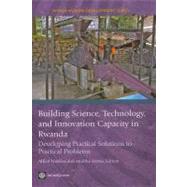
Note: Supplemental materials are not guaranteed with Rental or Used book purchases.
Purchase Benefits
What is included with this book?
| Foreword | p. ix |
| Acknowledgments | p. xiii |
| Abbreviations | p. xv |
| Executive Summary | p. xvii |
| Overview and Summary of Results | p. 1 |
| Current Social and Economic Situation | p. 2 |
| Improving the Lives of the Rural Poor, Reducing Poverty, and Achieving the MDGs | p. 4 |
| Creating Wealth and Diversifying the Economy | p. 6 |
| Government Commitment to STI Capacity Building | p. 8 |
| Methodology and Design of the STI Capacity-Building Program | p. 11 |
| Lessons Learned | p. 15 |
| Implementation Issues | p. 21 |
| Notes | p. 22 |
| The Food-Processing Industry | p. 25 |
| Situation Analysis/Needs Assessment | p. 25 |
| Standardization and Quality Management | p. 27 |
| Human Resource Constraints | p. 27 |
| Markets for Processed Foods | p. 28 |
| Development Potential for the Food-Processing Industry | p. 29 |
| Recommended Strategies | p. 30 |
| Educating and Training People | p. 32 |
| Developing Business Development Services | p. 33 |
| Improving Transport and Packaging | p. 34 |
| Conducting Market Research and Feasibility Studies | p. 34 |
| Adopting Complementary Measures | p. 35 |
| Value-Added Exports | p. 37 |
| Situation Analysis/Needs Assessment | p. 37 |
| Recommended Public-Private Partnerships for Capacity Building in Value-Added Enterprises | p. 40 |
| Public-Private Partnership for Technical and Vocational Training | p. 40 |
| Public-Private Grant Facility for Enterprise-Based Training | p. 41 |
| Establishing a Public-Private Technology Information Service | p. 42 |
| Establishing a Matching Grant Program for Investment in Productive Technologies | p. 43 |
| Creating a Public-Private Organic Production and Research Association | p. 43 |
| Building Capacity for Organic Production and Certification | p. 45 |
| Public-Private Instruments for Capacity Building in Design and Product Development | p. 45 |
| Notes | p. 46 |
| Development and Diffusion of Appropriate Technologies | p. 47 |
| Situation Analysis/Needs Assessment | p. 47 |
| Agencies and Institutions Responsible for Promoting Appropriate Technology | p. 51 |
| Factors Hampering the Development and Transfer of Appropriate Technology | p. 54 |
| Recommended Strategies | p. 55 |
| Building Capacity at CITT | p. 56 |
| Building Capacity at IRST | p. 58 |
| Building Capacity at Vocational Training Centers | p. 59 |
| Establishing a Technology Development Fund | p. 60 |
| Notes | p. 62 |
| Delivery of Clean Drinking Water | p. 63 |
| Situation Analysis/Needs Assessment | p. 63 |
| Recommended Strategies | p. 65 |
| Training Local Water Technicians | p. 65 |
| Training District- and National-Level Managers | p. 68 |
| Building Capacity at KIST | p. 68 |
| Building Capacity at NUR | p. 69 |
| Building Capacity at ISAE | p. 70 |
| Geosciences and Geothermal Energy | p. 71 |
| Fast-Track "Urgent" Plan for Geothermal Resource Assessment and Pilot Power Generation | p. 72 |
| Institutional Set-Up | p. 74 |
| Capacity Building through Hands-On Training | p. 74 |
| Long-Term Institution/Capacity Building for Geothermal Energy and Geoscience Development: The Rwanda Geoscientific Center | p. 75 |
| Required Capacity-Building Efforts | p. 80 |
| Notes | p. 82 |
| Client-Focused Agricultural Research and Outreach | p. 83 |
| Situation Analysis/Needs Assessment | p. 83 |
| Weaknesses in the Performance of the Agricultural Research and Technology Transfer System | p. 85 |
| Weaknesses in the Public Research and Technology Transfer System | p. 86 |
| Weaknesses in Private Sector Participation | p. 88 |
| Weaknesses in the Agricultural Education and Training System | p. 88 |
| Recommended Strategies for Capacity Building | p. 89 |
| Strengthen the Key Components of the Agricultural Research and Technology Transfer System | p. 89 |
| Empower the Beneficiaries of Agricultural Research and Outreach | p. 90 |
| Promote the Profitability of Agriculture and Private Sector Participation | p. 91 |
| Improve ISAR's Institutional Performance | p. 93 |
| Improve Coordination, Methods, and Performance Standards for Agricultural Research and Technology Transfer | p. 94 |
| Develop and Manage Human Resources | p. 95 |
| Build Capacity at ISAE and NUR | p. 96 |
| Notes | p. 97 |
| Appendixes | |
| Background Documents | p. 99 |
| Sample Terms of Reference for the Needs Assessment and Action Plan Studies | p. 101 |
| Public Institutions Involved in STI Capacity-Building Action Plans | p. 105 |
| Bibliography | p. 107 |
| Index | p. 109 |
| Table of Contents provided by Ingram. All Rights Reserved. |
The New copy of this book will include any supplemental materials advertised. Please check the title of the book to determine if it should include any access cards, study guides, lab manuals, CDs, etc.
The Used, Rental and eBook copies of this book are not guaranteed to include any supplemental materials. Typically, only the book itself is included. This is true even if the title states it includes any access cards, study guides, lab manuals, CDs, etc.